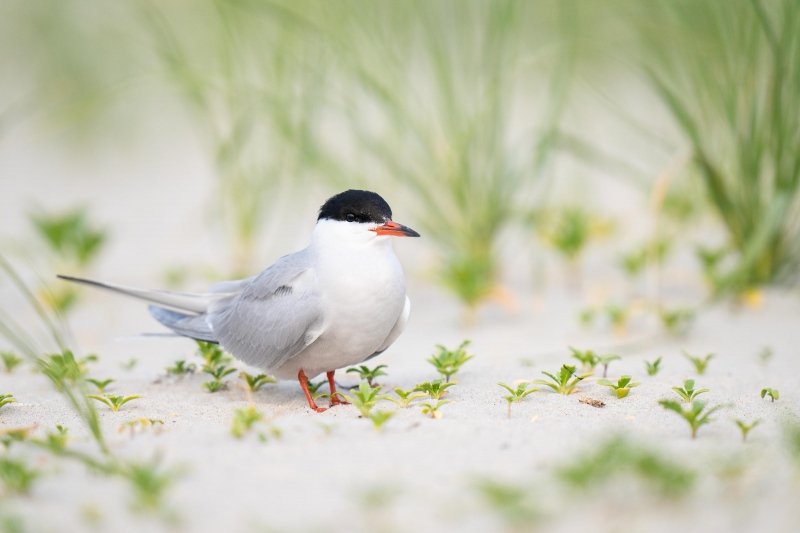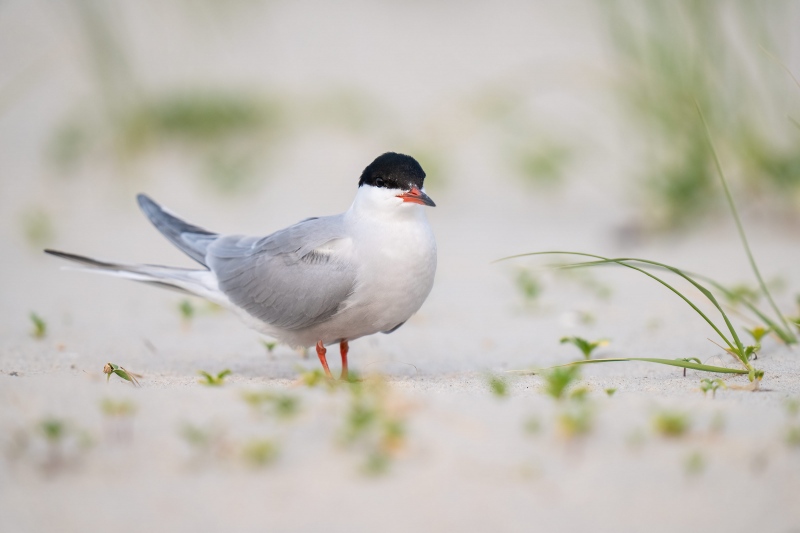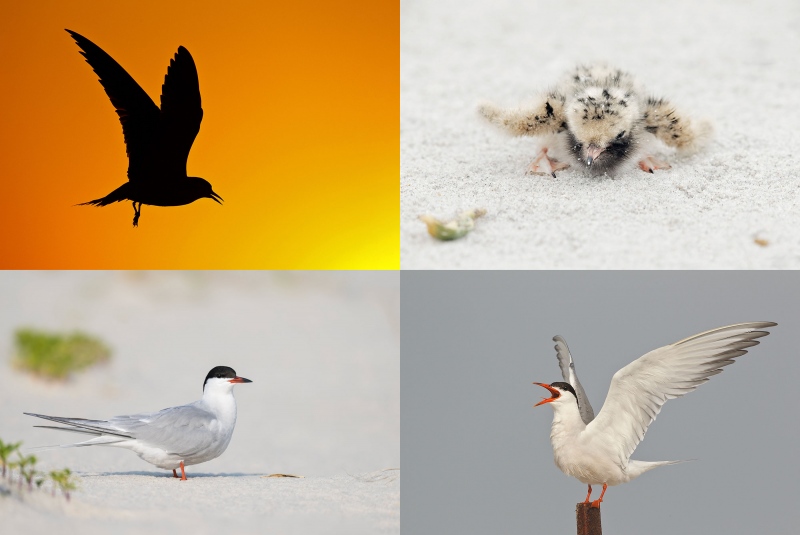My Call
In the last blog post, my top pick was the oystercatcher in the swash image for its simplicity and its beauty. That said, I really liked the foraging terns image as well.
Your Call
Of today’s two featured images, do you like the knee-pod perspective of Image #1 or the heel-pod perspective of Image #2. Why? Learn both of these techniques by joining me at Nickerson Beach in the third week of June. Details below.
Can you tell which of today’s two images was not noisy reduced?
What’s Up?
A few days ago, I became engrossed with the Netflix series Mindhunter. Yesterday, I finished watching all the episodes from the first (and only) two seasons. I will begin watching all of them again today. I have gotten lots of work done on the flight photography guide that I am co-writing with Arash Hazeghi. My incision has been a bit tender as expected but there are no signs of infection. The stitches are supposed to be removed on Monday.
I am looking forward to visiting Nickerson Beach again as soon as I get the all-clear from my Doctor Puopolo.
Today is Friday 2 June 2023. I plan on doing lots of writing and working on some more Bonaire flamingo images. Wherever you are and whatever you are doing, I hope that you too are gonna have a great day.
All are cordially invited to join me next year on a Homer or a San Diego Instructional Photo Tour (IPT). I will be announcing fall dates for two or three Fort DeSoto IPTs soon. Not to mention a Galapagos Photo-Cruise of a Lifetime in August 2024.
Please remember to use the B&H and Amazon links that are found on most blog pages and to use the BIRDSASART discount code at checkout when purchasing your new gear from Bedfords to get 3% back on your credit card and enjoy free second-day air FedEx. Please, also, consider joining a BAA IPT. You will be amazed at how much you will learn!
You can find some great photo accessories (and necessities, like surf booties!) on Amazon by clicking on the Stuff tab on the orange/yellow menu bar above. On a related note, it would be extremely helpful if blog-folks who, like me, spend too much money on Amazon, would get in the habit of clicking on the Amazon logo link on the right side of each blog post when they shop online. As you might expect, doing so will not cost you a single penny, but would be appreciated tremendously by yours truly. And doing so works seamlessly with your Amazon Prime account.
Please remember that if an item — a Delkin flash card, or a tripod head — for example, that is available from B&H and/or Bedfords, is also available in the BAA Online Store, it would be great, and greatly appreciated, if you would opt to purchase from us. We will match any price. Please remember also to use my B&H affiliate links or to earn 3% cash back at Bedfords by using the BIRDSASART discount code at checkout for your major gear purchases. Doing either often earns you free guides and/or discounts. And always earns my great appreciation.
Carlotta’s Sony 600mm f/4
Carlotta made a mistake when she purchased this lens. It turned out to be too large and heavy for her. She used it for a grand total of one afternoon. On the B&H used scale, this lens would be a perfect 10.
Sony FE 600mm f/4 GM OSS Lens
BAA Record-low Price!
Multiple IPT veteran Carlotta Grenier is offering a Sony FE 600mm f/4 GM OSS lens (USA warranty) in like-new condition for a BAA record low $9,797.00. The lens was used just once. The sale includes the rear lens cap, the lens trunk, the original front lens cover, the lens strap, the original product box and everything that came in it, and insured ground shipping via major courier to lower 48 US addresses only. Your item will not ship until your check clears unless other arrangements are made.
Please contact Carlotta via e-mail.
The 600mm f/4 lenses have been the state of the art super-telephotos for birds, nature, wildlife, and sports for many decades. I never leave home without mine. In short, they are the weapons of mass destruction for nature and sports photographers. The Sony 600 GM is the best ever as it is super-sharp with both the 1.4X TC and the 2X TC. I even shoot flight at 1200mm! It is the lightest 600 f/4 ever manufactured. And with most of the weight to the rear, it the best balanced 600 out there, and thus, is easier to handhold than any of its competitors. This lens sells new for $12,998.00 and is rarely in stock. If you have been dreaming of a Sony 600mm f/4 for years, grab Carlotta’s pretty much new lens right now and put $3,001.00 in savings into your pocket. artie
|
|
|
This image was created on 24 May 2023 at Nickerson Beach Park, Lido Beach, Long Island, NY. Seated on dry sand, I used the knee-pod technique with the handheld Sony FE 400mm f/2.8 GM OSS lens with the Sony FE 1.4x Teleconverter and The One, the Sony Alpha 1 Mirrorless Digital Camera.. ISO 1250: 1/1250 second at f/4 (wide open) in Manual mode. AWB at 7:00:01pm on cloudy evening with storm clouds to the west. Tracking: Expand Spot AF/C with Bird Face/Eye detection enabled performed perfectly. Be sure to click on the image to enjoy the high-res version. Image #1: Common Tern in preferred nesting habitat |
Common Tern Nesting Habitat
On sandy beaches, Common Terns favor areas with sparse vegetation for nesting. Scattered, low-growing beach vegetation provides cover for the chicks. The female terns fashion shallow scrapes in the sand in which they typically lay two to four eggs. Some nests may include a few pebbles or shell fragments.
The scientific name for Common Tern is Sterna hirundo. “Stearn” first appeared in a poem entitled The Seafarer, written around 1000 A.D. Linnaeus adopted this word for the genus name for several species of terns, Sterna. The Latin word for swallow is hirundo. That gets us to swallow-like tern.
I have scoped out the two best locations for photographing the nesting terns at Nickerson. One is great in the afternoon, the other on clear mornings. Along with American Oystercatcher families and more than a thousand Black Skimmers, the Common Tern will be the stars of the show at Nickerson on the June IPT (details below).
|
|
|
This image was also created on 24 May 2023 at Nickerson Beach Park, Lido Beach, Long Island, NY. Seated on dry sand, I used the foot-pod technique with the handheld Sony FE 400mm f/2.8 GM OSS lens with the Sony FE 1.4x Teleconverter and The One, the Sony Alpha 1 Mirrorless Digital Camera.. ISO 2000: 1/2500 second at f/4 (wide open) in Manual mode. AWB at 7:00:45pm on cloudy evening with storm clouds to the west. Tracking: Expand Spot AF/C with Bird Face/Eye detection enabled performed perfectly. Be sure to click on the image to enjoy the high-res version. Image #2: Common Tern in preferred nesting habitat |
Lower Extremities Pod Techniques
I have been using the knee-pod technique for as long as I can remember. Resting your left forearm atop your bent left knee will put your lens about 18 inches above the ground offering a fairly low perspective and greatly reducing fatigue. With the knee-pod, you have your eye to the viewfinder. It is fairly easy to follow moving subjects, frame unexpected action, and shoot flight (all of those assuming that the lens is not too heavy for you.
When employing the following techniques, you will be working off the tilted rear monitor. If you wear reading glasses, you will definitely want to have a pair with you so that you can get a decent look at the subject (and the head angle!), and so that you can note the position of the active AF point or points. While these techniques provide lovely low perspectives and soft, out-of-focus backgrounds, they make it difficult or impossible to follow running birds or to frame unexpected action. Or to shoot flight.
For several years I used the ankle-pod technique to get the lens about five inches off the ground. This technique provided a really low perspective and a very intimate perspective. But it was difficult to keep the lens perfectly steady. Friend David Pugsley introduced me to the toe-pod technique on a Jacksonville IPT two years ago. Sitting on the ground with his legs outstretched and flat, he supported the lens atop his toes. This placed the lens about ten inches or so above the beach and was more stable than the ankle-pod technique. To get even lower, point your toes out and support the lens with the inside of your heels, the heel-pod (of foot-pod) technique. That puts the lens only inches above the ground.
You may wish to experiment and get even lower by placing the lens hood on the ground and your left hand below the camera to support it and to aim and level the lens. Activating the electronic level helps you keep square to the world but can be somewhat distracting.
|
|
Common Terns are among the stars of the Nickerson show in June |
Summer 2023 Nickerson Beach Terns, Skimmers, & Oystercatchers Instructional Photo Tour (IPT): 3 1/2 (or 4 1/2) DAYS. Monday afternoon, June 19, thru the full day on Thursday June 22 (or Friday June 23), 2023. 3 1/2 Days: $1899.00 includes three working brunches. (4 1/2 Days: $2199.00 includes four working brunches). Limit six photographers
The Summer 2023 Nickerson Beach Terns, Skimmers, & Oystercatchers IPT
I am offering two options for this IPT. Locals might prefer the 3 1/2 day IPT. Folks traveling from out of town will almost surely want to maximize their travel dollars by staying the extra day. The stars of the show will likely be the nesting Common Terns. As many have been on eggs for a week or more, we should get to photograph some small chicks and lots of birds in flight with fish. We should have lots of American Oystercatcher families with chicks of varying sizes. Photographing them at dawn along as they forage along the edge of the surf is an exciting experience. We will get to photograph early morning skimmer flock blast offs, lots of afternoon midair battles, and will likely have some skimmers on eggs. Flight photography for all three species will abound.
Many folks head home feeling that while our time in the field was fabulous and productive, that the working brunch sessions were even more valuable. During image review you will learn to select the best images from several thousand made with your 20- and 30 fps camera bodies. And we will process a few images and distribute the screen capture videos for you to learn from after the trip. And all IPTs offer follow-up image critiques.
Change your life: sign up for this IPT today. Please shoot me an e-mail if you would like to explore the possibility of renting some Sony gear (including an a1) from me.
Some of What You Will Learn on a Nickerson Beach IPT
- 1- The basics and fine points of digital exposure; how to get the right exposure every time after making a single test exposure (or before if you are using SONY gear).
- 2- How and why to work in Manual mode (even if you’re scared of it).
- 3- How to approach free and wild birds without disturbing them.
- 4- Lots about bird behavior and how to use that knowledge to help you create better images.
- 6- To spot the good and great situations and to choose the best perspective.
- 7- To see, evaluate, and understand the light.
- 8- To design pleasing images by mastering your camera’s AF system.
- 9- And perhaps most importantly, to evaluate wind and sky conditions and understand how they affect bird photography. You will learn where and when to be (and why).
- 10- More than you could ever imagine.
The Details
We will be on the beach very early to enjoy sunrise. The morning sessions will run at least 3 1/2 hours. Afternoon sessions will begin at 6:00pm and run till sunset. There is never a set schedule on an IPT — we adapt to the conditions. On cloudy mornings with the right wind, we may opt to photograph till 11:30am or so and skip the afternoon session. That especially when the afternoon weather is looking iffy.
There will be a Photoshop/Image Review session before and after brunch (included) each full day. That will be followed by Instructor Nap Time. Each of these IPTs will run with only a single registrant as I do not like disappointing anyone. The best airports are JFK or Slip (if you have lots of Southwest points. Once you register, you will receive an e-mail with lodging information. Do know that it is always best if IPT folks stay in the same general area (rather than at home or at a friend’s place a good distance away).
Folks attending this IPT will be out in the field ridiculously early and stay out late to take advantage of sunrise and sunset colors; this is pretty much a staple on almost all BIRDS AS ART Instructional Photo-Tours. Doing so will often present unique photographic opportunities, opportunities that will be missed by those who need their beauty rest and those who need to get home for a proper dinner. I really love it when I am leaving the beach at 9:00am on a sunny morning after a great session just as a carful or two of well-rested photographers are arriving … We may be getting our feet wet on occasion, especially in the mornings, but those who wish to keep their feet 100% dry can do so.
Your $599 deposit is due now. Credit cards are OK for that. You can register by calling Jim or Jennifer during weekday business hours at 863-692-0906 with a credit card in hand. Once you leave a deposit, you will receive an e-mail with your balance statement and instructions for sending your balance check ASAP for this short-notice IPT. Those who wish to pay for the trip in one fell swoop via check may do so by making the check out to BIRDS AS ART and then mailing it to BIRDS AS ART, PO BOX 7245, Indian Lake Estates, FL 33855. You will receive a confirmation e-mail with detailed instructions, and clothing and gear advice right after you register. Please shoot me an e-mail if you plan to register or if you have any questions.
IPT veterans and couples or friends signing up together may e-mail for discount information.
Typos
With all blog posts, feel free to e-mail or to leave a comment regarding any typos or errors.

















Head angle is better in image #1
I am in agreement with the majority above for the reasons discussed. Further, the birds environment in this case adds to the photo and the story; and is in no way distracting.
No.1 is far, far better for me. I really like it. I like seeing a bit more of the feet (from the knee pod technique), having the vegetation a little more in focus, and seeing the eye better. And a big winner is the composition using the vegetation really well.
Image #1 and image #2 of Common Tern in preferred nesting habitat are both well made and cute pictures of the birds!
I prefer #1. Love how you’re essentially shooting through the foreground and not over it. It also brings more of the beautiful, diffuse green of the background into play.
Mindhunter is a terrific show. Cameron Britton’s portrayal of Edmund Kemper is one of the creepiest performances in television history. The show’s creators had planned a 4-season arc, but Netflix unceremoniously dumped the show. There is hope another studio picks it up to finish the story.
Agree on Mindhunter. I love the interplay between agents Bill Tench and Holden Ford. Jonathan Groff is absolutely brilliant as Ford.
On thing is for sure, Netflix is not gonna pick it up. I’d love to see two more seasons.
with love, artie
Hey Pugs, The two, Groff and McCallany, are great friends in real life. Check out the great interview here.
a
Artie
I am going with #1 as i see the head angle is gooder and the legs, feet are better in view than in image #2 and nicely placed in-between the grasses in the BG. I am a little surprised you kept #2 or it could be your learning perspective for all….like me 🙂
I also think you didn’t noise thingy to #2 as my guess.
Always with love b